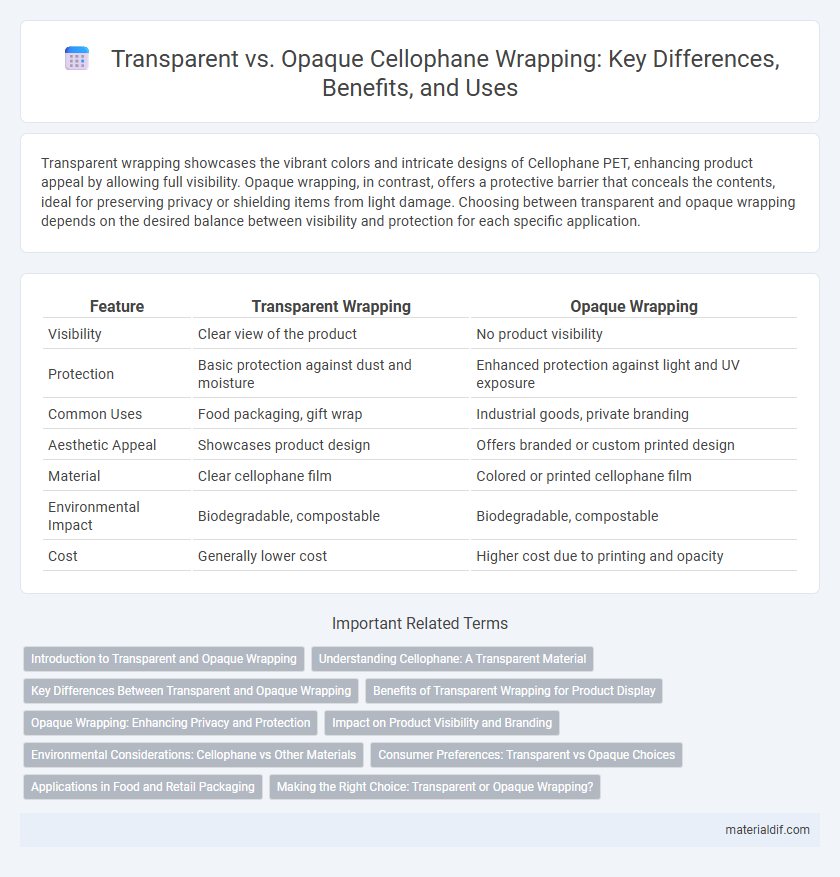Transparent wrapping showcases the vibrant colors and intricate designs of Cellophane PET, enhancing product appeal by allowing full visibility. Opaque wrapping, in contrast, offers a protective barrier that conceals the contents, ideal for preserving privacy or shielding items from light damage. Choosing between transparent and opaque wrapping depends on the desired balance between visibility and protection for each specific application.
Table of Comparison
| Feature | Transparent Wrapping | Opaque Wrapping |
|---|---|---|
| Visibility | Clear view of the product | No product visibility |
| Protection | Basic protection against dust and moisture | Enhanced protection against light and UV exposure |
| Common Uses | Food packaging, gift wrap | Industrial goods, private branding |
| Aesthetic Appeal | Showcases product design | Offers branded or custom printed design |
| Material | Clear cellophane film | Colored or printed cellophane film |
| Environmental Impact | Biodegradable, compostable | Biodegradable, compostable |
| Cost | Generally lower cost | Higher cost due to printing and opacity |
Introduction to Transparent and Opaque Wrapping
Transparent wrapping, such as cellophane, offers clear visibility of packaged contents, enhancing product appeal and consumer trust by allowing direct inspection without opening. Opaque wrapping conceals the product, providing protection from light and preserving freshness, thus ideal for items sensitive to exposure and requiring privacy or branding emphasis. Both wrapping types serve distinct roles in packaging strategy, balancing visual presentation and product preservation.
Understanding Cellophane: A Transparent Material
Cellophane is a transparent wrapping material made from regenerated cellulose, prized for its clarity and biodegradability compared to opaque alternatives that block visibility. Its transparency allows consumers to see the product within, enhancing marketing appeal while maintaining moisture resistance and breathability. Unlike opaque wraps that obscure content, cellophane provides both protection and visibility, making it ideal for packaging food, flowers, and gift items.
Key Differences Between Transparent and Opaque Wrapping
Transparent wrapping allows full visibility of the product, enhancing appeal and enabling customers to inspect items without unwrapping, which is crucial for food packaging and retail displays. Opaque wrapping, in contrast, provides better protection against light, moisture, and contamination, preserving product freshness and quality, especially for sensitive goods like pharmaceuticals and cosmetics. While transparent materials often use polyethylene or cellophane, opaque wrapping utilizes kraft paper or foil, impacting cost, durability, and environmental considerations.
Benefits of Transparent Wrapping for Product Display
Transparent wrapping enhances product visibility, allowing consumers to see the item's color, texture, and quality without opening the package, which boosts buyer confidence. It supports brand transparency, showcasing product authenticity and reducing the likelihood of tampering or misrepresentation. This type of packaging also improves shelf appeal, increasing the chances of impulsive purchases by making the product more attractive and accessible.
Opaque Wrapping: Enhancing Privacy and Protection
Opaque wrapping provides superior privacy by completely concealing the contents, making it ideal for sensitive or confidential items. Its thick, non-transparent material offers enhanced protection against light, moisture, and physical damage, preserving product quality and extending shelf life. This type of wrapping is widely used in industries where safeguarding the contents from external factors is crucial.
Impact on Product Visibility and Branding
Transparent wrapping such as cellophane enhances product visibility by allowing consumers to see the actual item, which builds trust and boosts impulse purchases. Opaque wrapping obscures the product, creating a sense of mystery that can be leveraged for premium branding but may reduce immediate consumer assurance. Transparent packaging significantly supports brand transparency and authenticity, while opaque materials emphasize luxury and exclusivity.
Environmental Considerations: Cellophane vs Other Materials
Cellophane, made from cellulose, is biodegradable and compostable, offering a more environmentally friendly alternative to many plastic-based opaque wrappings that rely on petroleum-derived polymers and contribute to long-lasting landfill waste. Transparent cellophane allows consumers to see the product inside without additional packaging layers, reducing material usage and waste compared to opaque wrappings that often require excessive labeling and secondary packaging. While opaque plastic wraps can provide better UV and light protection, the trade-off comes with lower recyclability and higher environmental impact relative to cellophane's sustainable attributes.
Consumer Preferences: Transparent vs Opaque Choices
Consumers often prefer transparent wrapping for its ability to showcase product quality and freshness, increasing trust and purchase intent. Opaque wrapping appeals to those prioritizing privacy, protection from light, or aesthetic branding elements that create a sense of luxury or exclusivity. Market trends indicate rising demand for transparent cellophane in food packaging due to its visual appeal and perceived hygiene benefits.
Applications in Food and Retail Packaging
Transparent wrapping, such as cellophane, offers high visibility and allows consumers to inspect food products directly, enhancing trust and appeal in retail packaging. Opaque wrapping provides better protection from light, preserving the freshness and quality of light-sensitive food items like chocolates and dairy. Both types are strategically used in packaging to balance product protection, marketing, and consumer experience in the food and retail sectors.
Making the Right Choice: Transparent or Opaque Wrapping?
Transparent wrapping offers clear visibility of products, enhancing consumer trust and appeal, especially for food and gift packaging where showcasing contents is crucial. Opaque wrapping provides superior protection against light, preserving product freshness and preventing spoilage, ideal for sensitive items like chocolates or pharmaceuticals. Selecting between transparent and opaque wrapping depends on balancing visibility with protection requirements to optimize product presentation and shelf life.
Transparent Wrapping vs Opaque Wrapping Infographic

 materialdif.com
materialdif.com